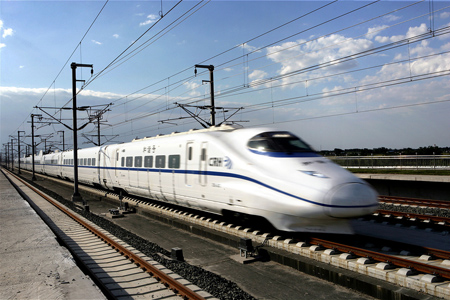|

The high-speed railway triangle involving three lines connecting Nanjing with Shanghai and Hangzhou, respectively, and Shanghai with Hangzhou. It will speed up economic integration in the delta region. |
A railway triangle will soon take shape in the Yangtze River Delta area as groundwork on a high-speed passenger rail line between Shanghai and Hangzhou began in late February.
The new railway, together with two other lines connecting Nanjing with Shanghai and Hangzhou, respectively, will speed up economic integration in the delta area, a major manufacturing base, said analysts.
When the railway triangle involving the three lines is completed in 2011, passengers will be able to travel between any of the three cities within an hour. The current up-to-eight-hour slog from Hangzhou, capital of Zhejiang province, to Nanjing, capital of neighboring Jiangsu province, will no longer detour through Shanghai and will be only 50 minutes.
"Regional economic integration must be supported by an efficient transportation network, especially rail lines," Chen Wei, a researcher with the Shanghai Academy of Social Sciences, told Xinhua.
The high-speed railway between Shanghai and Hangzhou is expected to kick off before the 2010 World Expo in Shanghai. Trains will run up to 350 km an hour on the 159-km line and the travel time between the two cities will fall from over an hour to 38 minutes. Trains will run at three-minute intervals at rush hour.
Shanghai and Hangzhou, are two of China's most economically affluent cities and fast economic growth in the Yangtze River Delta has generated huge demand for passenger and cargo transportation within the region.
"Rail capacity in the Yangtze River Delta region has reached saturation point," Yu Jian'er, chairman of the Zhejiang Provincial Railway Investment Group Co Ltd, told Xinhua. He said cargo transport is often suspended to make way for passenger trains during peak travel seasons.
The high-speed rail lines will cost 29.68 billion yuan. The Ministry of Railways will pay half of the construction costs. Caijing magazine reported that the Shanghai municipal government and the governments of regions of Zhejiang province that the new railways will pass through will contribute 40 percent and the rest will come from businesses.
Baosteel Group, China's largest steelmaker, said earlier that it plans to invest 2 billion yuan in the Shanghai-Hangzhou high-speed railway and hold an 8 percent stake in the project. The 2-billion yuan deal is the Chinese steel industry's largest investment in a railway-building project.
Caijing magazine reported that investors will set up a joint-stock company to carry out the project and will consider issuing corporate bonds to raise capital to cover construction costs.
Yu said earlier that the Ministry of Railways will try to list the rail line on the stock market in the future. The line would be the third Chinese railway to go public after the Guangzhou-Shenzhen line in the south and the Datong-Qinhuangdao line in the north.
The Shanghai-Hangzhou high-speed railway is the first project to begin construction since the State Council, China's cabinet, announced its economic stimulus package in November. The package focuses on infrastructure projects such as new railways, roads, airports, as well as rebuilding communities devastated by an earthquake in Sichuan last May.
The country plans to double its investment in railways to about 600 billion yuan this year according to the Ministry of Railways.
Part of the 600 billion yuan will go to building 5,148 km of new lines, including five passenger-only high-speed lines this year, Minister of Railways Liu Zhijun said late last year. The ministry also plans to start 70 other new projects this year, which will cost 1.5 trillion yuan by the time they are finished.
The annual investment in railways between 2010 and 2012 will be no less than 600 billion yuan, the ministry said. By 2012 China will have 110,000 km of rail lines, 13,000 km of them passenger routes. Many will be high-speed networks allowing trains to run between 200 and 350 km an hour.
|


